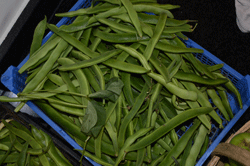Have You Got Beans Coming Out Of Your Ears?
Turn your back for 5 minutes at this time of year and you’ll find another French bean or runner bean has reached harvestable size. But what do you do with the glut, to make the most of your harvest and avoid waste?
My first tip is to do your best to avoid gluts through 3 simple steps:
- Succession planting
Plant fewer seeds, but every 4 weeks, from late April onwards. That way you stagger your harvest over many months from June to the October frosts, rather than arriving by the kilo in one month. - Harvest little & often
Rather than harvesting once a week, harvest your beans every few days. Not only does this keep the plant producing for longer (it doesn’t end up stopping its flowers because it thinks it has set its seeds).
Picking beans each time you want to eat them takes a little longer, but means you’ve always got just the number you need at optimal freshness. - Remember it’s not all about the pods
Most varieties of French and runner beans can either be eaten as young, tender pods, or as shelled beans, such as cannellini or haricot.
If you have a glut of young pods, you might want to let a few of your plants ‘set seed’, by letting the inner beans get bigger. Be aware that this can stop the plant producing any more flowers, so it can be best to select a number of plants to do this, whislt continuing to focus on young, fresh pods from the other plants.
What If You Already Have A Glut?
In summer, a glut can take you by surprise.
We had thought we were keeping on top of our harvest this year, but we picked about 3kg of various bean types this weekend.
They will keep for up to a week in the fridge, but try to force 6lb of beans down their throats and they might refuse to eat them again for the rest of the summer! 😉
So what can you do?
The main options are freezing or drying.
The ‘third way’ of salting, for example, runner beans, is one that appeals less to me, as it uses so much salt and dramatically impacts the taste. So we tend to stick to freezing and drying. Here’s how we do it:
How to freeze your French bean / runner bean harvest
- Choose younger, more tender pods, that won’t be stringy.
- It can be easier to store and then use the beans if you prepare them for eating first – usually by trimming the stalk end and then cutting into pieces.
- Bring a large pan of water to the boil and plung the beans in. Cook for about 1 minute, then drain and plunge into cold water, to stop the cooking process.
- Drain them well in a colander and allow to cool completely, before freezing in bags.
- They will keep throughout the winter, in a good quality freezer.
- To use them, simple boil them for a couple of minutes and serve.
How to dry your French bean / runner bean harvest
- Choose the largest pods, with very visible beans.
- Strip the beans from the pods. The pods will compost well – or they make a treat for chickens, if you have any.
- Give the beans a wash and drain them well.
- Sort through the beans, discarding any that show signs of mildew or other diseases.
- Once sorted, you can either dry them in a low-temperature dehydrator or on a wire rack in an airing cupboard.
- Keep drying until they are totally dry. This may take a few days.
- Store in airtight jars.
- To use, soak overnight and boil as for pulses. Or, for beans other than kidney beans, you could experiment with sprouting them.
Have you had any gluts of beans this year? What have you been doing with them? We’d love to hear your suggestions via the comments box below or via our Facebook Veg Patch Diaries community.
Posted on August 22, 2011, in French Beans and tagged how to grow french beans, how to grow runner beans, storing french beans, storing runner beans. Bookmark the permalink. Leave a comment.












Leave a comment
Comments 0